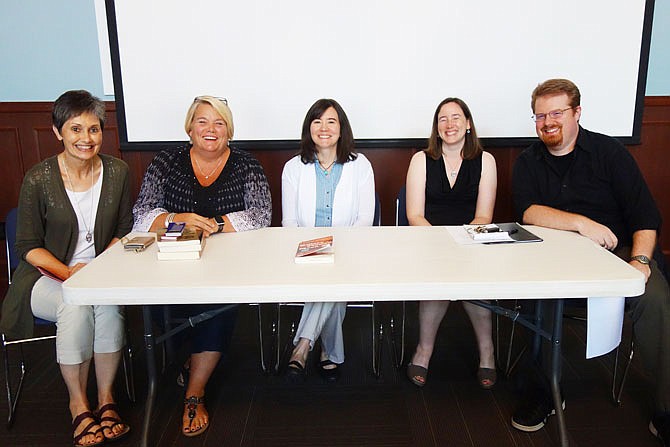It's easy to get on the FBI watch list, Barri Bumgarner discovered.
You just have to plot to kill off 98 percent of the Earth's population.
Bumgarner is an assistant professor of education at Westminster College. She's also the author of thrillers like "Slipping" and "8 Days." Her books tend to feature creative deaths.
"I just always have to kill someone off," she told the audience at a Thursday afternoon One Read panel discussion.
Bumgarner began work on her first novel, "8 Days," while she was teaching junior high in the early 2000s. In "8 Days," scientists decide to use weapons of mass destruction to give Earth a hard reset.
One day in 2002, she got a phone call.
"What's your interest in weapons of mass destruction?" the caller demanded to know.
The voice at the other end of the line sounded suspiciously like a practical joker friend of hers.
"I said, 'I teach junior high. Don't we all want to kill people?'" Bumgarner recalled.
The caller was not her prankster pal. In fact, it was Tom Ridge, then assistant to the United States president for homeland security. He was not amused.
Flustered, Bumgarner explained she was writing a book. Upon request, she sent Ridge a copy of her manuscript - and later, after the book was published and selling well thanks to the homeland security publicity boost, a signed first edition.
She got a similar call while working on her second book, in which a schizophrenic serial killer poisons his victims with chemical weapons. By then, the FBI knew the drill.
"I offered to send them a copy of that manuscript too," she said. "They said, 'No, we trust you.' After that, I was notified that I was officially on the FBI watch list."
While this continued to be good publicity, it also got in the way of her research process on her next book, which involved visiting prisons and taking flights. Those are things folks on the FBI watch list are discouraged from doing, she discovered.
Despite the roadblocks, Bumgarner dug deep into her chosen subject: the alleged murder of 23-year-old University of Missouri student Jesse Valencia by his lover, Columbia police officer Steven Rios. Rios was convicted of the crime in 2005.
Bumgarner visited him in jail years later.
"He said, 'You can't interview me, but I'll interview you,'" Bumgarner said.
Despite Rios' arrogant attitude, Bumgarner slowly came to believe Rios didn't commit the crime for which he was convicted. The Innocence Project is now looking into that possibility, she said.
"Despite the probability that he's innocent, he'll likely spend the rest of his life in jail," Bumgarner added.
Literary parallels
Bumgarner was just one of several Westminster professors who spoke at Thursday's panel discussion. This year's One Read book, "Killers of the Flower Moon," tells the true story of the murders of several wealthy Osage Native Americans in the early 1920s. This crime spree influenced the formation of the FBI.
In order to tell that story, author David Grann spent five years digging through archives and tracking down descendants of the victims and murderers alike. In doing so, he uncovered something no one was meant to find: a vast conspiracy to hush those deaths up.
The other panelists saw parallels between Grann's work and the works of other authors.
Carolyn Perry, professor of English at Westminster, compared the way Grann handles thorny historical issues to novelist Toni Morrison's writing. Grann's subjects inhabit a world filled with racial prejudice.
In her novel "Beloved," Morrison tells about an escaped slave's decision to kill her children rather than risk them being re-enslaved.
"This is the depth of history," Perry said. "What some people might see as a brutal murder, others might see as the deepest act of love."
Nate Leonard, an associate professor of English, saw similarities between the villains of Grann's book and those in Shakespeare. Shakespeare's bad guys, such as Richard III, "kind of revel in their own evil," Leonard said.
"This black and white morality was a very comfortable concept in 16th and 17th century England," he explained.
By framing the villains as willingly and knowingly evil, Shakespeare made them easy to root against. Real life is rarely that simple - but the eponymous killers in "Killers of the Flower Moon" are quite Shakespearean, Leonard added.
Finally, English professor Theresa Adams talked about how early FBI agents were surprisingly similar to Sherlock Holmes. Holmes stories were published from 1891 through the 1920s, she said. As a consulting detective, Holmes was described as professional, gentlemanly and scientific in his investigative methods.
"Hoover wanted his agents to project professionalism," Adams explained.
But unlike a Holmes story, where everything is neatly resolved at the end and the world is set aright, Grann's tale has an uglier beginning and ending.
"The world of this book is not a garden of Eden," she said. "It's lawless, corrupt and racist."

